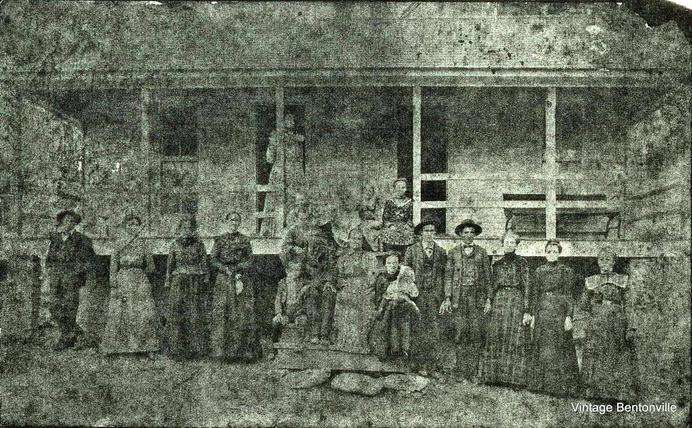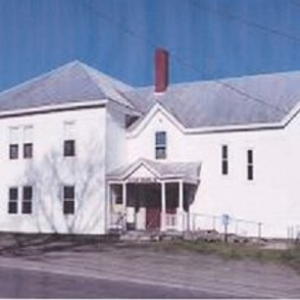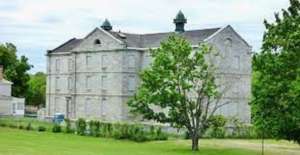Local student graduates from Rensselaer Polytechnic Institute
/0 Comments/in Benton, School News/by Website Editor On May 20, 2023, Rensselaer Polytechnic Institute (RPI), in Troy, New York, awarded a bachelor of science degree in business and management to Drake Zimba, of Benton.
On May 20, 2023, Rensselaer Polytechnic Institute (RPI), in Troy, New York, awarded a bachelor of science degree in business and management to Drake Zimba, of Benton.Up and down the Kennebec Valley: How towns cared for their poor (conclusion)
/0 Comments/in Benton, Central ME, Clinton, Fairfield, Kennebec County, Local History, Up and Down the Kennebec Valley, Waterville, Winslow/by Mary Growby Mary Grow
Benton, Clinton, Fairfield, Waterville, Winslow
This fourth and final article on the ways central Kennebec Valley towns carried out their responsibility to care for their poorest residents will provide bits of information about half a dozen towns not already discussed.
* * * * * *
For Benton (which was part of Clinton until March 16, 1842, when it became a new town named Sebasticook, changed to Benton on March 4, 1850), Henry Kingsbury had only one sentence about paupers: “The poor of the town have never been numerous, and are cared for [in 1892] by individual contract.”
In his Kennebec County history, he related an informal example. In the early 1800s, he wrote, a family named Piper proposed moving from Anson, Maine, to Ohio. As they were canoeing down the Kennebec, the canoe upset at Ticonic Falls, in Waterville, and the father drowned.
A second-generation Benton resident named Isaac Spencer rescued the Piper son, Joseph, “snugly wrapped in a blanket,” and brought him to his house. Joseph’s mother also survived, but she could not support her son, so he stayed with Spencer.
Kingsbury wrote that Joseph Piper “became a successful farmer.” He died in the 1850s, leaving a large estate on part of which a grandson named Charles was living in 1892.
* * * * * *
Kingsbury wrote that Clinton’s first poor farm, which existed before Benton and Clinton were separated in 1842, was “about half a mile west of Morrison’s Corner.”
Morrison’s Corner was, and as Morrison Corner still is, the four corners where Hinckley Road, running roughly north to south, meets Battle Ridge Road, which runs northeast to connect to Upper Bellsqueeze Road, and Ferry Road, which runs southwest to the former Noble’s Ferry on the Kennebec River.
By 1879, according to that year’s Kennebec County atlas, Clinton had a new town farm east of the original one, on the east side of Hill Road (which runs north-northwest out of downtown Clinton toward Canaan).
* * * * * *
Crossing back to the west side of the Kennebec, the 1988 Fairfield bicentennial history has no reference to a town farm, poor house or almshouse or any other town-funded method of caring for paupers. The first town meeting after the town was incorporated was on Aug. 19, 1788; the first reference to appropriations says that in 1793 “The Town first raised money for schools,” but lists no amount and mentions no other expenditures.
The history gives a short paragraph to what became the Goodwill-Hinckley School (described in the May 20 and June 3, 2021, issues of The Town Line). Rev. George W. Hinckley founded what started as Good Will Farm in June 1889, in the part of Fairfield now called Hinckley, “as a home for boys.”
In November 1889, the history continues, “the Good Will Home Association was organized as a home for needy boys with funds Rev. Hinckley had been collecting for some time.” The writers go on to describe 20th-century changes.
At the end of the bicentennial history is a reproduction of a 1909 map of Fairfield that shows a building labeled “Town Farm.” It is on the south side of a road running east from Green Road to Nye’s Corner, which is south – downriver, toward the Fairfield business district – of the Goodwill School.
A map from the mid-1980s shows the former road as a trail. It does not appear in any form on a contemporary on-line map.
(According to the 1909 map, the town farm was a short distance east of a four-way intersection where at least two families named Green lived. There was a schoolhouse on the east side of the intersection.)
* * * * * *
Waterville was part of Winslow from 1771 to 1802, and Oakland was part of Waterville until 1873, when it became a separate town called West Waterville (changed to Oakland in 1883).
Kingsbury explained that the growth of water-powered manufacturing on Messalonskee Stream, the outlet of Messalonskee Lake, led to the development of an industrial center separate from Waterville’s, which was based on and near the Kennebec.
Kingsbury’s accounts of poor farms in Winslow, Waterville and Oakland are frustratingly incomplete. As he often did, he assumed future readers would have access to the same documents he had, and would recognize the names of families, roads and localities that were part of his daily experience in the 1890s.
In his chapter on Winslow, he wrote that until 1859, paupers were bid off. That year, “the town voted $3,200, and bought the Blanchard farm.”
If the former Blanchard farm was still the town farm when the 1879 Kennebec County atlas was created, it was in a part of town more settled than officials usually chose for an almshouse.
The map shows the Town Farm on the west side of what is now Clinton Avenue (Route 100) running northeast along the Sebasticook River to Benton. The farm is marked about halfway between the top of the hill in Winslow and the Hayward Road intersection. Along this stretch, the map shows a dozen houses (occupied by, among others, several Getchell and Fuller families and two whose last name was Town) and a schoolhouse diagonally north of the town farm.
Kingsbury was slightly more informative on Waterville (unlike the Waterville centennial history; the summary of the 100 years from 1802 to 1902 doesn’t mention the poor, and since the book has a names-only index, finding any other reference is time-consuming).
In Waterville, Kingsbury found, the poor were bid off from 1811 (or earlier) until about 1842. In 1811, five paupers cost the town from 35 to 65 cents a week, for a weekly total of $2.59. In 1812, the town supported a dozen people and the cost went up to $3.48 a week.
(Ruby Crosby Wiggin’s comments about doctors’ fees, cited in last week’s article, suggest there might have been occasional additional charges.)
From 1837 records Kingsbury quoted a decision that the poor as a group “be sold at auction for one year.” Samuel H. Batchelder was the successful bidder, charging $865.
Around 1842, Waterville officials bought from Joseph Mitchell and George Bessey a 90-acre farm to use as a town farm. At an unspecified later date, the town also acquired a woodlot in Sidney, apparently intended to complement the farm.
The 1879 Kennebec County map shows Waterville’s town farm a short distance south of downtown, on the south side of Webb Road. It was just west of the intersection with Mitchell Road, which current maps show coming south from the back of LaFleur Airport to Webb Road.
In March 1890 the house on the town farm burned down. Officials then bought seven acres from George Boutelle and “built the present excellent city alms house at a total expense at $6,444.”
(George Keely Boutelle was a prominent Waterville lawyer and businessman who helped organize and lead several banks and was active in civic organizations.)
By 1892, Waterville’s “poor department” was costing more than $9,000 a year, Kingsbury added.
The 1873 separation of West Waterville (which became Oakland) from Waterville would have required the new town to assume the care of its indigent residents. The 1879 map of the new town shows a town farm not far west of downtown, on the north side of what is now High Street (Route 137 heading west toward Smithfield). Comparison with a contemporary on-line map puts the farm site about half-way between the Oak Street intersection and the Gage Road intersection.
Kingsbury provided evidence that in the early 1890s Oakland was both running a town farm and caring for paupers off the farm. Appropriations listed in a town report for the fiscal year that ended Feb. 28, 1892, included “support of poor,” $1,100 and “town farm,” $500.
A current on-line map labels the road along the east shore of McGrath Pond that connects Route 137 with Route 11 (the Oakland-Belgrade road) as Town Farm Road. A town farm on this road, if there were one, would have been west of the one in use in 1879.
Story of the Bray sisters
Did local methods of caring for the poor lead to those who were bid off to local families being turned into unpaid and mistreated farm and household help? Linwood Lowden said “without doubt” the system led to abuses; an on-line source says there is no evidence of abuse.
Your writer found one piece of writing that looks at bidding out from the paupers’ viewpoint: a short story by Sarah Orne Jewett called The Town Poor.
Two prosperous women in a small Maine town detour on their way home from a church event to visit two elderly sisters, Ann and Mandana Bray, who ran out of money and saw their house and possessions sold at auction and themselves bid out.
They live in a dingy upstairs room in a shabby farmhouse on a run-down farm. The couple with whom they live, named Janes, are not their social equals, and the complaining wife is not enthusiastic about sharing her house with two more adults. The sisters admit to their friends that they haven’t been to meeting because they lack outdoor shoes that their caretakers never remember to buy for them, nor do they have enough stovewood to keep their room warm.
But they bring out the four china teacups saved from the auction, the last of the homemade peach jam from the peaches that grew by their former house, tea and cheese and crackers. The friends have a warm reunion; and Ann says next time, she’ll invite Mrs. Janes, too; the woman means well and deserves cheering up, because she has a hard life and none of the happy memories the Bray sisters have.
See part 1 here.
See part 2 here.
See part 3 here.
Main sources
Fairfield Historical Society, Fairfield, Maine 1788-1988 (1988).
Halfpenny, H. E., Atlas of Kennebec County Maine 1879 (1879).
Jewett, Sarah Orne, A White Heron and Other Stories (1999 edition).
Kingsbury, Henry D., ed., Illustrated History of Kennebec County Maine 1625-1892 (1892).
Websites, miscellaneous.
Area residents named to dean’s list at UNE
/0 Comments/in Albion, Augusta, Benton, China, Fairfield, Jefferson, Oakland, Palermo, School News, Sidney, Skowhegan, Vassalboro, Waterville, Winslow/by Website Editor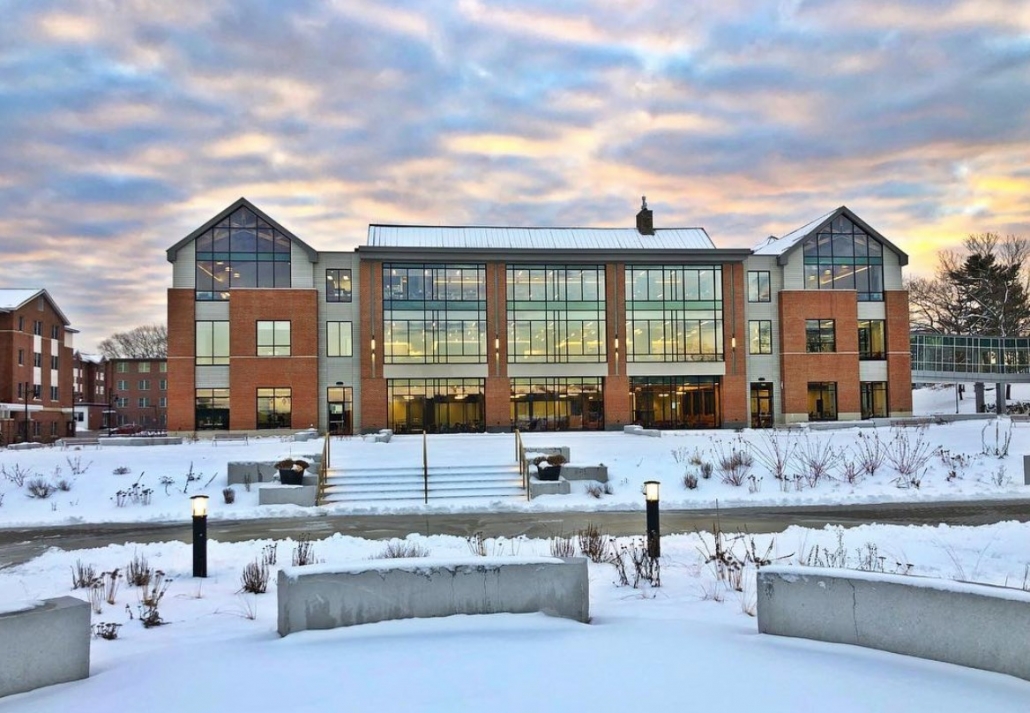
Photo credit: University of New England Facebook page
The following students have been named to the dean’s list for the 2022 fall semester at the University of New England, in Biddeford.
Albion: Emma McPherson and Olivia McPherson.
Augusta: Valerie Capeless, Zinaida Gregor, Jessica Guerrette, Brooklynn Merrill, Daraun White and Julia White.
Benton: Jessica Andrews.
Fairfield: Caitlyn Mayo.
Jefferson: Mallory Audette.
Oakland: Kierra Bumford and Francesca Caccamo.
Palermo: Peyton Sammons.
Sidney: Sarah Kohl.
Skowhegan: Wylie Bedard, Elizabeth Connelly, Ashley Mason and Dawson Turcotte.
South China: Richard Winn.
Vassalboro: Adam Ochs.
Waterville: Mohammad Atif-Sheikh, Elias Nawfel, Grace Petley and Evan Watts.
Winslow: Juliann Lapierre, Kristopher Loubier and Justice Picard.
SNHU announces summer ‘22 president’s list
/0 Comments/in Albion, Augusta, Benton, China, Clinton, Fairfield, Madison, School News, Vassalboro, Waterville, Winslow/by Website Editor Southern New Hampshire University (SNHU), in Manchester, New Hampshire, congratulates the following students on being named to the Summer 2022 President’s List. The summer terms run from May to August.
Southern New Hampshire University (SNHU), in Manchester, New Hampshire, congratulates the following students on being named to the Summer 2022 President’s List. The summer terms run from May to August.
Kate Murphy and Justin Drescher, both of Augusta, Matthew Bandyk, of Jefferson, Merval Porter, of Palermo, Lisa Johnson, of South China, Lacey York, of China, Lilly Reardon, of Benton, Jeffery Wheeler and Brendon Peace, both of Waterville, Talon Mosher, of Winslow, Jacob Colson, of Albion, Carrie Stackpole, of Clinton, Stormy Wentworth, of Fairfield, Glenn Rich and Mariah Rich, both of Madison, and Kassandra Grant, of Vassalboro.
China workshop aims to bring area towns together
/0 Comments/in Benton, Central ME, China, Community, Events, Kennebec County, Palermo, Sidney, Vassalboro, Weeks Mills, Windsor/by Eric W. Austin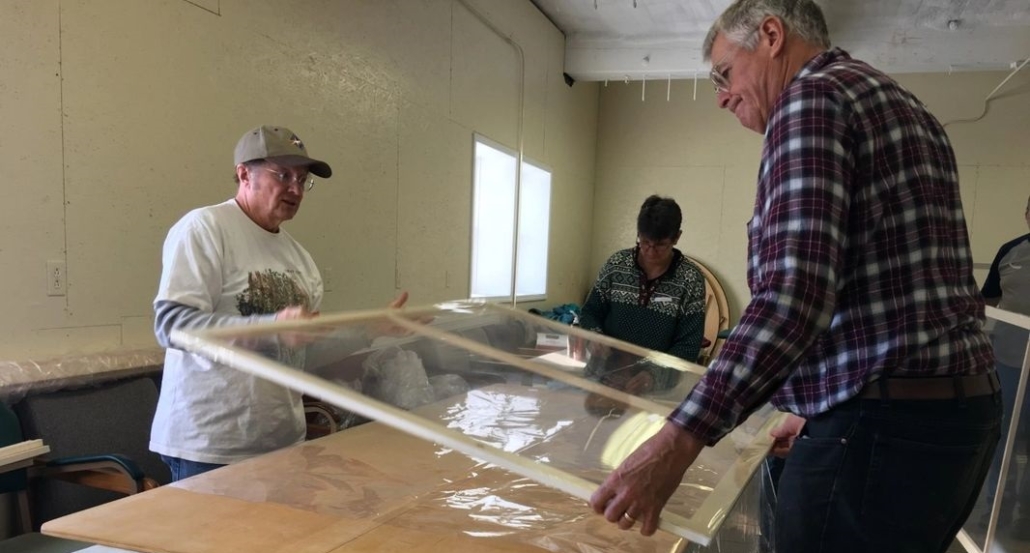
Volunteers prepare window inserts at a previous WindowDressers workshop, in Vassalboro. (photo courtesy of Vassalboro Historical Society)
by Eric W. Austin
CHINA, ME — Planned for the second week in November starting just after Election Day, the China Window Dressers workshop is moving full steam ahead. The intent of the workshop is to build low-cost window inserts to reduce heating expenses for homeowners in central Maine. The organizers have spent the past year taking orders and visiting local homeowners to measure the windows requiring inserts, and now they are looking for volunteers to help at the upcoming workshop.
Sponsored by the China for a Lifetime Committee, a local group dedicated to philanthropic activities meant to improve the quality of life for China residents, and assisted by other local organizations, the initiative is modeled after the classic “barn-raising” community efforts of the past, with residents working together for the benefit of everyone.
Committee chairman Christopher Hahn describes it this way: “The workshop is a great chance for the community to come together and help one another during these tough financial times. Such events don’t happen as often as they should anymore in this age of Facebook and online Zoom meetings, so we jumped at the opportunity to organize this workshop. It fits right in with our mission of ‘neighbors helping neighbors.’ I hope to see many familiar faces and hopefully some new ones.”
The committee has received more than 130 orders for window inserts from over two dozen local clients across central Maine. Although the workshop will take place at the China Conference Center, orders have been open from any of the area towns and volunteers for the upcoming build workshop do not need to have ordered inserts or live in China. The workshop will run from Wednesday, November 9, through Sunday, November 13. Work shifts are divided into a morning shift from 8:30 a.m. – 12:30 p.m., and an afternoon shift from 1 – 5 p.m. Food will be provided by community volunteers between shifts. The first two days are devoted to putting together the wooden frames for the window inserts, while the next two days will be for wrapping those frames in plastic and foam. Sunday will serve as an overflow day if everything cannot be completed by Saturday evening.
No experience is necessary to help out, and there are still plenty of spots that need to be filled. Hahn says they are aiming for eight people per shift. The work is not complicated, and designed to flow through an assembly line process, making it easy for anyone to participate. Participants from earlier workshops will be on hand to answer any questions and provide guidance for volunteers.
For those interested in signing up to participate in the workshop, there are several ways to get involved. The easiest way is to visit the Window Dressers website at windowdressers.org. Click on “Community Builds” link on the menu at the top-right of the page, then scroll down to the China build and click where it says “Sign up to volunteer”. (Click here to go there directly.) That will take you to a page where you can choose which time-slot best fits into your schedule.
If you’re not tech-savvy, or don’t have internet access, you can also send an email to ChinaforaLifetime@gmail.com or call the China town office at 445-2014 and let them know what days you are available to help.
More information about the China for a Lifetime committee can be found on their website at chinaforalifetime.com.
Up and down the Kennebec Valley: Natural resources – Part 5
/0 Comments/in Albion, Benton, China, Local History, Maine History/by Mary Growby Mary Grow
Previous articles have talked about some of the natural resources in the central Kennebec Valley, notably clay and granite. Renewables, like timber, fur-bearing and other game animals and fish, have been ignored – would an enterprising reader like to tackle one or more of those topics?
This piece will cover a varied assortment of other resources. As with those discussed before, information from local histories is scanty.
* * * * * *
Gold is unusual in Maine but not completely lacking. The Maine Geological Survey has on its website a list of streams, all but one in Franklin, Oxford or Somerset county, worth panning for gold. (The outlier is the St. Croix River, separating the United States and Canada; gold has been found in Baileyville, in Washington County.)
Locally, there might have been gold in the Albion-Benton area. One of the personal paragraphs in Henry Kingsbury’s Kennebec County history is about Augustine Crosby (1838 – 1898).
Born in Albion, son of Luther and Ethelinda Crosby and grandson of Robert and Abigail Crosby, Augustine spent 10 of his early years in Massachusetts; came back to Benton and went into lumbering; served in the Civil War (as did his father) and as of 1892 was in “the South” building sawmills.
While in Benton, Crosby married Asher Crosby Hinds’ daughter, Susan A. Hinds. And, Kingsbury wrote, “He invented a dredge for gold dredging and spent some time operating it.”
According to a Crosby family diary found online, Augustine fell ill in September 1898 and died Sept. 28. He was buried Sept. 30 in what the diarist wrote “was called Smiley burying ground.” The funeral was well attended, with 23 teams, the diarist believed, following the hearse. His wife survived him; the diarist mentioned several times her visits to and sympathy for Sue.
(See the website called Winslow Maine Crosby Diary for additional excerpts. The diarist was Elizabeth B. Hinds Crosby (1892-1912); the hand-written diary was transcribed by Clyde Spaulding, her great-grandson.)
(Asher Crosby Hinds [1863-1919] was a Benton native and Colby College graduate, Class of 1883. After newspaper work in Portland, in 1889 he got a position as clerk to the Speaker of the United States House of Representatives. He served in clerkship positions until 1911, editing the Rules, Manual, and Digest of the House of Representatives [1899] and Hinds’ Precedents of the House of Representatives [1908]. In 1911 he was elected to the first of three terms as a Republican Representative from Maine. He died in Washington, D.C., and is buried in Portland’s Evergreen Cemetery.)
In China, Indian Island (previously Round Island or Birch Island) in the east basin of China Lake was reported – inaccurately, it appears — to have gold deposits. Several sources cite prominent Quaker Rufus Jones’ memoir of his boyhood, in which he wrote that people dug over the whole island and found only pyrite, an iron sulphide often called “fool’s gold” because it is yellowish.
One more hint of local gold is found in Milton E. Dowe’s Palermo Maine Things That I Remember in 1996. Dowe wrote: “It’s known that there was a gold mine east of the Marden Hill Road [in north central Palermo]. I have been there to the site but never heard the facts of it.”
* * * * * *
Tin, described by Wikipedia as “a soft, silvery white metal with a bluish tinge,” that does not occur as “the native element” but has to be extracted from other ores, is another resource Kingsbury mentioned.
Mixing tin with copper creates bronze, as people discovered some 3,000 years B.C. Wikipedia does not list the United States as a source of tin. But Kingsbury related a story about tin in Winslow, Maine.
As he told it, about 1870 Charles Chipman noticed “[i]ndications of tin ore” in the rocks along a brook on J. H. Chaffee’s property. He and others, including Thomas Lang (a prominent citizen of Vassalboro) and a doctor from Boston, concluded it might be worth mining.
They organized a company and dug more than a hundred feet down, finding more tin as the shaft went lower, but not enough to cover costs, never mind make a profit. Kingsbury wrote that they gave up around 1882.
* * * * * *
One rather unusual resource is a mineral spring. Mineral springs are similar to ordinary springs, areas (often hillsides) where groundwater naturally comes to the surface because the ground slopes below the water table.
Wikipedia says a mineral spring contains dissolved minerals, especially salt, lime, lithium, iron and sulfur compounds, and sometimes harmful components like arsenic.
For generations people have believed some mineral springs are healthful. “Taking the cure” or “taking the waters” was popular, especially in 18th and 19th century Europe for upper-class Europeans and Americans. Spas have been developed around mineral springs as destinations for people seeking better health; Wikipedia’s illustrations include mineral spas in Europe, India and Iran.
Major mineral springs that have been developed in Maine include Blue Hill Mineral Spring near Blue Hill, in Hancock County, and especially Poland Spring, in Poland.
The spring in Blue Hill was “well-known” before a company was organized in 1888 to exploit its supposed healing properties, according to the Maine Memory Network. Blue Hill’s mineral water was sold nation-wide, including being available on Pullman cars on many eastern railroads. The company folded after a November 1915 fire destroyed its processing buildings.
In 2014, three former University of Maine professors wrote a short article on two mineral springs in Baxter State Park that contained potassium and sodium and served as salt licks for deer and moose.
Poland Spring, in Poland, is by far the best-known Maine spring. According to Wikipedia, the spring is on the lot where Jabez Ricker opened an inn in 1797. In 1844, Jabez’s grandson, Hiram Ricker, said drinking water from the spring had cured his chronic indigestion.
The inn was enlarged, more guests heard about the alleged properties of the water and the Rickers started bottling and selling it. The elaborate Poland Spring House opened in 1886.
There is still a hotel at the spring, Poland Spring Resort. Bottled water now sold under the Poland Spring label comes from more than one part of Maine.
Locally, there are records of mineral springs in Augusta and China.
James North wrote in his Augusta history that in 1810 there were two prominent mineral springs in the area. The Togus Mineral Spring, also called the Gunpowder Spring (North did not explain why) in Chelsea had become well-known as the enthusiasm for mineral waters spread. It was in a meadow; its water had been compared to water from a similar spring in Bowdoin.
Wikipedia adds that the name “Togus” probably came from a Native American word, worromontogus, which can be translated as “place of the mineral spring.” In 1858, a granite dealer from Rockland built the Togus Spring Hotel, with “a stable, large pool, bathing house, race track, and bowling alley.” The venture was unprofitable, and in 1866 the United States government bought the building for a veterans’ home.
According to North, a newly discovered spring in downtown Augusta, close to the Kennebec, was even more popular in 1810 than the Togus spring. He described the location by naming the owner of a nearby house that was on Water Street “opposite Laurel Street,” information that puts the mineral spring in the northern end of the business district, north of the Calumet bridge.
The mineral spring in China, according to local historian Clinton Thurlow, was northwest of South China village, on the west side of China Lake’s east basin. In one of his histories of the Wiscasset, Waterville and Farmington narrow-gauge railroad, Thurlow provided information on the branch line from Weeks Mills to Winslow that ran trains for a few years, beginning on July 9, 1902 (the tracks were removed about 1915, he wrote).
There was a dance pavilion in South China then, on the western edge of the village, and Thurlow wrote that the railroad would run excursions from Winslow to South China, taking passengers to the pavilion early in the evening and bringing them back to Winslow around midnight.
There was another popular place on the WW&F line to Winslow, not far north of the pavilion. Thurlow wrote: “A mineral spring between the Pavilion and Clark’s Crossing provided the occasion for many an unscheduled stop while train crews and passengers alike refreshed themselves.”
Clark’s Crossing was presumably the place where the tracks crossed the still-existing Clark Road that runs toward China Lake from what is now Route 32 North (Vassalboro Road). Your writer has found no other reference to this spring, but does not doubt its existence, because Thurlow talked with several former WW&F employees.
Update on Victor Grange
Victor Grange #49, in Fairfield Center, organized in 1874, first was profiled in this series on May 13, 2021. This year’s July 14 issue of The Town Line reported that Grange members were about to have the hardwood floors downstairs refinished, probably for the first time since the building opened in 1903.
Grange Lecturer Barbara Bailey reported on July 31 that the floors are done! Grange members intended to spend the first day of August cleaning up dust from the sanding and washing windows before they rehung curtains.
Wednesday, Aug. 3, is the scheduled day to move furniture – including two pianos – back in.
Bailey invites anyone interested in this building preservation and restoration work to contact her at 453-9476 or email baileybarb196@gmail.com. The Grange email address is victorgrange49@gmail.com.
Update on the July21 update on the Kennebec Arsenal
Augusta’s Kennebec Arsenal, a group of eight granite buildings dating from 1828-1838 and designated a National Historic Landmark District, has been discussed in two earlier articles in this series, in the Jan. 21, 2021, and Feb. 10, 2022, issues of The Town Line. The buildings have been privately owned since 2007; when the owner bought them from the state, he agreed to keep them in repair and maintain their historic value.
This writer’s July 21 update, citing a story by Keith Edwards of the Kennebec Journal, reported that the Augusta City Council was considering declaring the property dangerous. A declaration would let councilors have repairs made and bill the owner, or have the buildings demolished.
The council postponed a decision until its July 28 meeting, Edwards wrote. In the July 29 Kennebec Journal, he reported that after almost four hours of discussion, councilors again delayed a decision. They plan to continue the hearing at their next meeting, scheduled for Aug. 4, at 5:30 p.m.
Edwards wrote that Augusta Codes Enforcement Officer Rob Overton told council members the buildings were in deplorable condition inside and out. He estimated the cost of making them usable again at around $30 million.
The owner, accompanied by his lawyer, pointed out that he had reroofed all the buildings – Overton had exempted the roofs from his criticism – and made other repairs. He said he intends to ask for local permits to renovate five buildings by the end of August, planning to complete the work within two years.
The owner estimated the cost for that part of renovations at $1.76 million. For another $3.5 million, maximum, he said he could convert what Edwards called “the large Burleigh building” into upscale apartments.
Correction to above article
Benton historian Barbara Warren wrote to point out an error in the Hinds genealogy in the Aug. 4 piece on natural resources, the section on Augustine Crosby (1838-1898), who invented a gold dredge and married Asher Hinds’ daughter, Susan Ann Hinds (1837-1905).
This writer incorrectly identified Susan Hinds’ father as Asher Crosby Hinds, known as “the Parliamentarian.” Her father was actually Asher Hinds (1792- 1860), whom Warren calls “the builder” (he sponsored the building of the Benton Falls Meeting House in 1828 and in 1830 built the Benton Falls house in which Warren now lives). Warren describes him as “a prosperous farmer and merchant,” War of 1812 veteran and delegate to the Massachusetts General Court.
Susan Ann (Hinds) Crosby was Augustine Crosby’s third cousin and Parliamentarian Asher Crosby Hinds’ aunt. Her brother, another Asher Crosby Hinds, was born in 1840 and died in 1863 in the Civil War. The Parliamentarian’s father was Susan’s brother, Albert Dwelley Hinds (1835-1873).
The confusion is understandable, Warren wrote. For four generations, the Hinds family included an Asher; and Hinds and Crosbys often intermarried.
Main sources
Kingsbury, Henry D., ed., Illustrated History of Kennebec County Maine 1625-1892 (1892).
North, James W., The History of Augusta (1870).
Thurlow, Clinton F., The WW&F Two-Footer Hail and Farewell (1964).
Websites, miscellaneous.
Up and down the Kennebec Valley: Native Americans – Part 3
/0 Comments/in Benton, Kennebec County, Local History, Maine History, Sidney/by Mary Growby Mary Grow
Three local settlements
The Kennebec tribe’s village at Cushnoc (a word that means head of tide, most historians agree) was on high ground on the east bank of the Kennebec River in what is now Augusta, about 20 miles south Ticonic village (described last week).
Leon Cranmer, in his Cushnoc, pointed out that the high land provided views of river traffic both upstream and down and offered some protection against attack. Canoes could land in a cove at the foot of the bank (now, he wrote, a park and boat landing).
Charles E. Nash, in his chapters on Augusta in Henry Kingsbury’s Kennebec County history, wrote that Cushnoc village had wigwams, cultivated cornfields and open space for young men to practice “wrestling, running and dancing.”
Kerry Hardy, in a nicely-illustrated 2009 book titled Notes on a Lost Flute: A Field Guide to the Wabanaki, argued that Cushnoc was the west end of an important Native American trail that ran from the present town of Stockton Springs near the mouth of the Penobscot River (almost due east of Cushnoc) to the head of tide on the Kennebec River.
Looking at old maps, Hardy traced that east-west trail and found others that converged on Cushnoc, coming from present-day Rockland (on the coast to the southeast), Canton Point (on the Androscoggin River to the northwest) and Farmington Falls (on the Sandy River to the north).
Unfortunately, Hardy did not explain why Cushnoc was the center of a Native American communications network. Instead, he summarized the importance of the British trading post established there (as at Ticonic; and, as at Ticonic, the site of the trading post was later chosen for a fort).
Cranmer offered the theory that Cushnoc was a convenient mid-way place for Native Americans traveling between Canada and the coast to branch off to other parts of Maine.
During archaeological excavations around the trading post site between 1974 and 1987, Cranmer wrote, more than 17,500 artifacts were found, mostly signs of European rather than Native American habitation.
He specifically mentioned a few stone flakes left over as Kennebecs made their edged tools; a stone projectile point that appears from its photograph to be in excellent condition and could be anywhere from 2,200 to 6,000 years old; and a bit of pottery, the remains of what Cranmer called an Iroquoian-like jug or bowl.
If there was a Native American burial ground associated with Cushnoc, this writer has been unable to find a reference to it. J. W. Hanson, in an 1852 history of the area found on line, claimed that “the quiet graves of their [Kennebec tribal members’] fathers clustered around the mouth of each tributary to their beloved river,” but he offered no specific location.
The first British trader at Cushnoc was Edward Winslow from the Plymouth Colony in 1625, Nash wrote (or in 1628, according to Old Fort Western Director Linda Novak’s bicentennial lecture). He and successors traded European goods for Native American products, primarily beaver skins.
By the 1650s, trade and profits were diminishing, Nash said. In 1661 the Plymouth group sold the trading post to four other Europeans, who gave up and closed the operation about 1665.
Novak blamed the decline in trade at Cushnoc on rival traders Thomas Clark and Thomas Lake, who opened competing posts both upriver at Ticonic and downriver near current Pittston. James W. North, in his history of Augusta, blamed “growing Indian troubles” for the decline and said war was the final blow (the first war counted by historians, writing primarily from the Anglo-American point of view, started in 1675).
North listed other problems in the 1650s, including a decrease in fur-bearing animals, the Kennebecs’ recognition that the furs were more valuable than the goods offered in exchange and “the increasing number and avaricious disposition of the traders.”
Cranmer added two more problems that could have contributed to a smaller supply of furs: British settlements expanding into woodlands, and attacks on Maine Native Americans by Iroquois tribes from the northwest (current upstate New York and thereabouts).
In 1655, the governor of the Plymouth Colony appointed Captain Constant Southworth as magistrate at Cushnoc, responsible for administering civil law throughout the colony’s holdings. He had two main jobs, Nash wrote: to prevent other traders from trespassing and “to check the sale of demoralizing liquors to the Indians.”
Nash commented that Joseph Beane or Bane, an Englishman held captive by the Native Americans, reported that remains of the Cushnoc trading post were still visible “among the new-grown trees and shrubbery” in 1692. Novak, however, says the post was burned in 1676, during the first of the serial wars. Either account suggests the Kennebecs had no interest in using the building.
North wrote that the 1725-1744 interregnum in the Kennebec Valley wars was a genuine peace, during which the Kennebecs interacted peacefully with the British traders, who he suggested treated them fairly and even generously, and with early settlers. In 1732, Massachusetts Governor Jonathan Belcher and “a large retinue” toured the coastal settlements. The governor met with an unspecified group of Native Americans at Falmouth, and told them that he planned to establish three missionary stations in the province, one to be at Cushnoc, “where a town and church were about to be built.”
North offered no evidence of such a town, or of any pacifying influence from missionaries, before the final defeat of the French at Québec in 1759. Instead, continued Native American resistance delayed the growth of European settlements around Cushnoc for another generation.
* * * * * *
Besides the settlements at Ticonic/Winslow and Cushnoc/Augusta, Kennebec tribal members lived elsewhere along the Kennebec River, its tributaries and other nearby water bodies. Some of the town histories on which this writer relies describe evidences of pre-European occupation from Fairfield and Benton through Waterville/Winslow and Vassalboro/Sidney to Augusta.
The current Town of Benton has frontage on the Kennebec River, and the Sebasticook River runs (almost) north-south through (almost) the middle of town. The Sebasticook, like the Kennebec, was a major travel route for Native Americans.
Benton historian Barbara Warren says because of the rapids in the Kennebec above Ticonic (until Waterville manufacturers’ dams calmed them, beginning in 1792), upriver travel was via the Sebasticook to Benton Falls, about five miles upstream from the Kennebec, and a portage back to the Kennebec at Fairfield. The Sebasticook was also a connector between the Kennebec and Penobscot valleys, according to another source.
Kingsbury wrote that “the relics found many years ago at the foot of the hill overlooking Benton Falls are now the only traces of the original possessors of the soil.” The “hill” – high land – is the east bank of the river where Garland Road runs through Benton Falls Village. Warren remembers as a child walking along the river and finding artifacts like shards, grinding tools and “a stone weight for a fishing net.”
Warren says a state-listed archaeological site on the west side of the Sebasticook near the dam includes a burial ground. State preservation officials are protecting the exact location of the site. Your writer surmises there was a Kennebec village, at least seasonally for fishing and perhaps year-round for farming and hunting, on the east bank with the burial ground across the river, as at Ticonic.
A 1992 University of Maine at Farmington study of the banks of the lower Sebasticook, between the dams at Benton Falls and Fort Halifax, found 30 archaeological sites along that part of the river, dating from the Archaic period (in Maine, between 10,000 and 3,000 years ago, according to Wikipedia) and the early contact period in the 1600s.
A 2004 archaeological survey related to the Unity Wetlands covered the banks of the Sebasticook in Unity and a small part of Benton and found 16 riverside Native American sites. Ten of the sites were either near rapids or near a junction with a tributary stream.
In the 2004 study, the site at Benton Falls was described as having been used during the Archaic and Ceramic periods. Wikipedia says in Maine, the Ceramic period was between 3,000 and 500 years ago, or from about 1000 B.C. to about 1500 A.D.
Both the Farmington study and a Biodiversity Research Institute publication by C. R. DeSorbo and J. Brockway, found on line, mention pre-European fisheries for migrating river herring. Warren says there is evidence suggesting Native Americans built a two-tier stone fish trap where Outlet Stream from China Lake runs into the Sebasticook in Winslow, within a mile of the Kennebec.
In neither Benton nor Fairfield are there well-known evidences of pre-European settlement along the Kennebec. The Fairfield bicentennial history says Native Americans made arrowheads in an area called the sand hills in Larone, in northern Fairfield. Evidence cited included arrowheads, broken and unbroken, and chips from making the arrowheads (although collectors had picked up most of the chips).
The type of rock used to make the arrowheads was not found locally, the writers said. They surmised the Native Americans brought the rock from Moosehead.
In Alice Hammond’s 1992 history of the Town of Sidney, she quoted Dr. Arthur Speiss, of the Maine Historic Preservation Commission, saying there had been Native Americans in Sidney since “at least 5,000 years ago.” By 1992, Hammond wrote, the Historic Preservation Commission had found 11 pre-European sites along the Kennebec River and eight along Messalonskee Lake’s eastern shore.
The Town of Sidney’s 2003 comprehensive plan gives the number of pre-historic sites as 23. Maps show four areas along the Kennebec and three more on Messalonskee Lake. The plan explains that the exact locations are not publicized to protect the areas.
Hammond wrote that there was no valid way to estimate how many Native Americans lived in Sidney, nor are there individuals’ names or information on when the last groups left. She surmised they could have been gone by the 1740s.
Sidney does, however, have its legend, retold in Hammond’s history and in other sources, including Maine Indians in History and Legend.
According to that version, Messalonskee Lake is named from the Native American word “Muskalog,” or “Giant Pike,” a big, voracious fish that lived in the lake. The name further recognizes that 14 other water bodies empty into the lake, “which like the Giant Pike was never satisfied.”
A heroic brave named Black Hawk and a sneaky brave named Red Wolf both loved a lovely, lively maiden named White Fawn. White Fawn chose Black Hawk.
The evening they were formally engaged, White Fawn and Black Hawk stole away from the celebration for some private moments on a clifftop overlooking Messalonskee Lake. Red Wolf followed them, killed Black Hawk, whose body fell into the lake, and tried to kidnap White Fawn.
Screaming, she jumped from the cliff into the water. The rest of the tribe rushed to the scene. Red Wolf cried out “Messalonskee! Messalonskee!” As the avengers closed in on him, there was an earthquake and an avalanche swept him, too, into the ever-hungry lake.
Series of lectures available online
A series of 10 lectures on early Maine history presented at Old Fort Western in 2021 is now available for viewing on line. Topics include Native Americans, Fort Western and Fort Halifax and trading posts on the Kennebec River. Speakers include Dr. Arthur Speiss and Leon Cranmer, mentioned in this article. The series can be found by searching for Old Fort Western or Maine bicentennial lectures.
Main sources
Cranmer, Leon E., Cushnoc: The History and Archaeology of Plymouth Colony Traders on the Kennebec (1990).
DeSorbo, C. R. and J. Brockway, The Lower Sebasticook River: A landowner’s guide for supporting one of Maine’s most unique and important ecosystems. (2018).
Fairfield Historical Society, Fairfield, Maine 1788-1988 (1988).
Hammond, Alice, History of Sidney Maine 1792-1992 (1992).
Hardy, Kerry, Notes on a Lost Flute: A Field Guide to the Wabanaki (2009).
Kingsbury, Henry D., ed., Illustrated History of Kennebec County Maine 1625-1892 (1892).
Maine Writers Research Club, Maine Indians in History and Legends (1952).
North, James W., The History of Augusta (1870)
Warren, Barbara, email exchange.
Websites, miscellaneous.
Area residents named to University of New England dean’s list
/0 Comments/in Albion, Augusta, Benton, China, Oakland, School News, Sidney, Waterville, Winslow/by Website Editor The following students have been named to the dean’s list for the 2021 fall semester at the University of New England, in Biddeford. Dean’s list students have attained a grade point average of 3.3 or better out of a possible 4.0 at the end of the semester.
The following students have been named to the dean’s list for the 2021 fall semester at the University of New England, in Biddeford. Dean’s list students have attained a grade point average of 3.3 or better out of a possible 4.0 at the end of the semester.
Olivia McPherson, of Albion; Valerie Capeless, Zinaida Gregor, Jessica Guerrette, Brooklynn Merrill and Julia White, all of Augusta; Sidney Knox, of Benton; Alden Balboni, Kierra Bumford and Tyler Pellerin, all of Oakland: Sarah Kohl and Olivia Roy, both of Sidney; Julia Steeves and Dawson Turcotte, both of Skowhegan; Lauren Boatright, Noelle Cote and Richard Winn, all of South China; Libby Breznyak and Lauren Pinnette, both of Waterville; and Juliann Lapierre and Justice Picard, both of Winslow.
Interesting links
Here are some interesting links for you! Enjoy your stay :)Site Map
- Issue for July 25, 2024
- Issue for July 18, 2024
- Issue for July 11, 2024
- Issue for July 4, 2024
- Issue for June 27, 2024
- Issue for June 20, 2024
- Issue for June 13, 2024
- Issue for June 6, 2024
- Issue for May 30, 2024
- Issue for May 23, 2024
- Issue for May 16, 2024
- Issue for May 9, 2024
- Issue for May 2, 2024
- Issue for April 25, 2024
- Issue for April 18, 2024
- Issue for April 11, 2024
- Issue for April 4, 2024
- Issue for March 28, 2024
- Issue for March 21, 2024
- Issue for March 14, 2024
- Issue for March 7, 2024
- Issue for February 29, 2024
- Issue for February 22, 2024
- Issue for February 15, 2024
- Issue for February 8, 2024
- Issue for February 1, 2024
- Sections
- Our Town’s Services
- Classifieds
- About Us
- Original Columnists
- Community Commentary
- The Best View
- Eric’s Tech Talk
- The Frugal Mainer
- Garden Works
- Give Us Your Best Shot!
- Growing Your Business
- INside the OUTside
- I’m Just Curious
- Maine Memories
- Mary Grow’s community reporting
- Messing About in the Maine Woods
- The Money Minute
- Pages in Time
- Review Potpourri
- Scores & Outdoors
- Small Space Gardening
- Student Writers’ Program
- Solon & Beyond
- Tim’s Tunes
- Veterans Corner
- Donate



